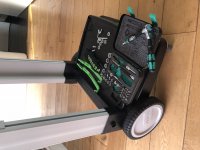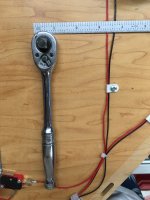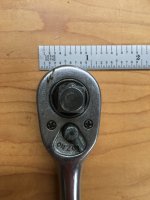You are using an out of date browser. It may not display this or other websites correctly.
You should upgrade or use an alternative browser.
You should upgrade or use an alternative browser.
One for 6 point socket
- Thread starter VW mick
- Start date
six-point socket II
Member
- Joined
- Jun 26, 2016
- Messages
- 2,248
*yay* [big grin] [big grin] [big grin]
Great shot! And where would the fun be when using just the supplied allen wrench [big grin] [big grin] [big grin]
Thank you!!!
Kind regards,
Oliver
Great shot! And where would the fun be when using just the supplied allen wrench [big grin] [big grin] [big grin]
Thank you!!!
Kind regards,
Oliver
six-point socket II
Member
- Joined
- Jun 26, 2016
- Messages
- 2,248
Thats really interesting and I would love to hear the reasoning behind it!
I always thought, especially with typical mechanic's use accessibility was key - and the really wide head of the Zyklop ratchet doesn't really fit that bill.
So was it the rotatable head he liked for general use over common ratchets?
Kind regards,
Oliver
I always thought, especially with typical mechanic's use accessibility was key - and the really wide head of the Zyklop ratchet doesn't really fit that bill.
So was it the rotatable head he liked for general use over common ratchets?
Kind regards,
Oliver
it was the fact that it rotated and locked into position, his Snap-Ons rotated but did not lock. He probably has $100,000 worth of Snap-ons. The other thing he liked was the kit case and selection...he is going to buy one for his remote/pickup jobs. He and his son have done our personal and work vehicle repairs and service for 30 years. We have not let a selling dealer work on our vehicles for that entire length of time. He's worked our Fords, Jeeps, Dodges, Toyotas, and my wife's Audi TT. I deep telling him that he works to cheap but he does the things he loves...I know the feeling.
Cheese
Member
Having wrenched on cars, motorcycles, lawnmowers, boats and 3 & 4 wheelers for the last 50+ years, that Wera ratchet is a club. It may be nice to use in controlled space situations, but in limited space situations it will get thrown out the door as fast as that unruly pizza dough you hate so much.
There’s a reason why the head of a Snap-on ratchet is very narrow. There’s also a reason why SK ratchets have so many fine teeth. It’s called accessibility and a professional mechanic willingly pays the price differential for both of these tools because it makes his job easier.
I like Wera tools but this ratchet club is not their best offering for mechanics...however, it may be fine for woodworkers. [smile]
There’s a reason why the head of a Snap-on ratchet is very narrow. There’s also a reason why SK ratchets have so many fine teeth. It’s called accessibility and a professional mechanic willingly pays the price differential for both of these tools because it makes his job easier.
I like Wera tools but this ratchet club is not their best offering for mechanics...however, it may be fine for woodworkers. [smile]
Lol! Funny you should say that. I bought a 3/8” wera ratchet many years ago. It never grew on me. A handful of fine tooth ratchets filled up my toolbox over the years...predominantly for fixing the cars. The wera sits in the basement toolbox with my woodworking tools. [tongue]
six-point socket II
Member
- Joined
- Jun 26, 2016
- Messages
- 2,248
Hi,
[member=25351]rst[/member] Thanks for the info!
Kind regards,
Oliver
[member=25351]rst[/member] Thanks for the info!
Kind regards,
Oliver
VW mick
Member
- Joined
- Apr 27, 2014
- Messages
- 881
This the big brother
I like it a lot. But as stated above I’m not a mechanic but I do the occasional job on my camper and woodwork
I built a deck for a friend last week and it was perfect for coach bolts raw bolts etc
M10 bolts
I suppose the head is big but it is handy to be able to adjust it
which snap on would you recommend for the smaller head
Thanks mick [attachimg=1]
I like it a lot. But as stated above I’m not a mechanic but I do the occasional job on my camper and woodwork
I built a deck for a friend last week and it was perfect for coach bolts raw bolts etc
M10 bolts
I suppose the head is big but it is handy to be able to adjust it
which snap on would you recommend for the smaller head
Thanks mick [attachimg=1]
Attachments
leakyroof
Member
- Joined
- Mar 23, 2011
- Messages
- 2,538
. You had to ask——- Here goes...VW MICK said:This the big brother
I like it a lot. But as stated above I’m not a mechanic but I do the occasional job on my camper and woodwork
I built a deck for a friend last week and it was perfect for coach bolts raw bolts etc
M10 bolts
I suppose the head is big but it is handy to be able to adjust it
which snap on would you recommend for the smaller head
Thanks mick [attachimg=1]
Any of their 3/8” ratchets are great- your choice for plain metal body and handle ( the Classic), or their newer soft material handle options, which I use every day, in standard length or the very long version when I need the leverage.
My 2 ‘sneaky’ versions are the all metal stubby / short 3/8” ratchet and its very narrow brother that is basically a 1/4” ratchet body with a 3/8” square drive assembly instead of 1/4” drive.
The True Beauty of the Stubby 3/8” ratchet is when you want to increase your ‘feel’ of starting a fastener and you have a fair amount of extension attached to the ratchet . Almost like using your fingertips to start the screw or bolt since the feedback is sensitive due to your hand placement on that short ratchet versus a standard length one. Also, being short, you can spin it faster in tight areas then finish up with your needed final torque using a longer ratchet.
For Spark Plug work, the classic angled handled 3/8” ratchet with the flex head is still useable and relevant 30 years after I bought it.
I actually could sell off my original Metal bodied 3/8” ratchet that I used for 2 decades before finally accepting the thicker soft material handled versions Snap-On started offering.
The Gen 1 versions had issues with the material used, and Snap-On quietly started swapping them out for the current version.
For General use, their Standard length ratchet in either head tooth count are fine as all around ratchets. If you don’t need a Fine tooth ratchet, then stick with whatever is stock these days and just decide on Handle Style per your choice....
Cheese
Member
The cool thing about Snap-on is that like Festool, McIntosh, Randall and Rolex, the values of their products appreciate in value every single year. I can sell any of those products mentioned for more than I purchased them for. So what’s not to like?
You use them and at some time you sell them for a profit. Life is good...
You use them and at some time you sell them for a profit. Life is good...
Cheese
Member
VW MICK said:which snap on would you recommend for the smaller head
Just to put things into perspective, I went downstairs and took a couple photos of a 3/8" drive Snap-on and a 3/8" drive SK.
1. 3/8" drive Snap-on
2. The Snap-on is a maximum of 1 1/8" wide
3. The 3/8" drive SK is only 1/4" wider
Interestingly enough, the Snap-on is about 50 years old while the SK is a recent purchase...it's only about 30 years old. [big grin]
Attachments
Cheese said:Just to put things into perspective, I went downstairs and took a couple photos of a 3/8" drive Snap-on and a 3/8" drive SK.
1. 3/8" drive Snap-on
2. The Snap-on is a maximum of 1 1/8" wide
3. The 3/8" drive SK is only 1/4" wider
Interestingly enough, the Snap-on is about 50 years old while the SK is a recent purchase...it's only about 30 years old. [big grin]
Do you have them all wired to electric as a theft deterrent? [eek] [big grin]
I think 1/4" is quite a bit in the ratchet world. How about the equally important head thickness?
-----------------------------------------------------------------------------------------------------------------------------------------
I think the Wera ratchets would be more comparable to other roto ratchets. Though it is a ratchet ..... different type for different use. Lots of mechanics have lots of different ratchets.
I recently expanded my wrenches , ratchets, etc. Ended up with Gearwrench ratchet and socket sets. I don't use them everyday, but I am very happy with the GW tear drop head ratchets. Especially like the 9" long 1/4" drive for slender reach access.
Seth
Cheese
Member
SRSemenza said:Do you have them all wired to electric as a theft deterrent? [eek] [big grin]
I think 1/4" is quite a bit in the ratchet world. How about the equally important head thickness?
I should have used that approach when I was part of a communal garage. [smile]. But that’s another story...
As would be expected, the Snap-on is also the thinner of the two at just a smidge over 1/2” thick. However, in typical Snap-on fashion, they placed the ratchet direction lever on the socket side of the head where any additional height would be negligible. The ratchet direction lever on the SK, like almost all other brand ratchets is on the outside of the head which adds to the thickness of the head. In this case almost .200”.
Worse yet though is that by being on the outside of the head and when used in tight spaces, the direction lever can be easily bumped and the ratchet direction will be changed. That has happened to me often. That’s one of the reasons the SK is relegated to house projects and the Snap-on does genuine mechanics duty.
leakyroof
Member
- Joined
- Mar 23, 2011
- Messages
- 2,538
. That’s a very old Snap-On ratchet... Thry haven’t had the direction lever on the square drive side of the head for many years. Another BIG plus of your ratchet is that you can’t trap the direction lever against something as you’re ratcheting a bolt out in a confined area and then realized your mistake and want to change direction .Cheese said:SRSemenza said:Do you have them all wired to electric as a theft deterrent? [eek] [big grin]
I think 1/4" is quite a bit in the ratchet world. How about the equally important head thickness?
I should have used that approach when I was part of a communal garage. [smile]. But that’s another story...
As would be expected, the Snap-on is also the thinner of the two at just a smidge over 1/2” thick. However, in typical Snap-on fashion, they placed the ratchet direction lever on the socket side of the head where any additional height would be negligible. The ratchet direction lever on the SK, like almost all other brand ratchets is on the outside of the head which adds to the thickness of the head. In this case almost .200”.
Worse yet though is that by being on the outside of the head and when used in tight spaces, the direction lever can be easily bumped and the ratchet direction will be changed. That has happened to me often. That’s one of the reasons the SK is relegated to house projects and the Snap-on does genuine mechanics duty.
With current designs , the lever is on the opposite side and once you trap a ratchet , you are now using an O-ring pick or small screwdriver to hopefully flip the lever back over and reverse your direction. At least with your style , if a socket doesn’t completely cover that lever to begin with, it might be easier to ‘unstick your stuck’ situation.... [wink]
Similar threads
- Replies
- 5
- Views
- 56K
- Replies
- 3
- Views
- 435
- Replies
- 23
- Views
- 1K





